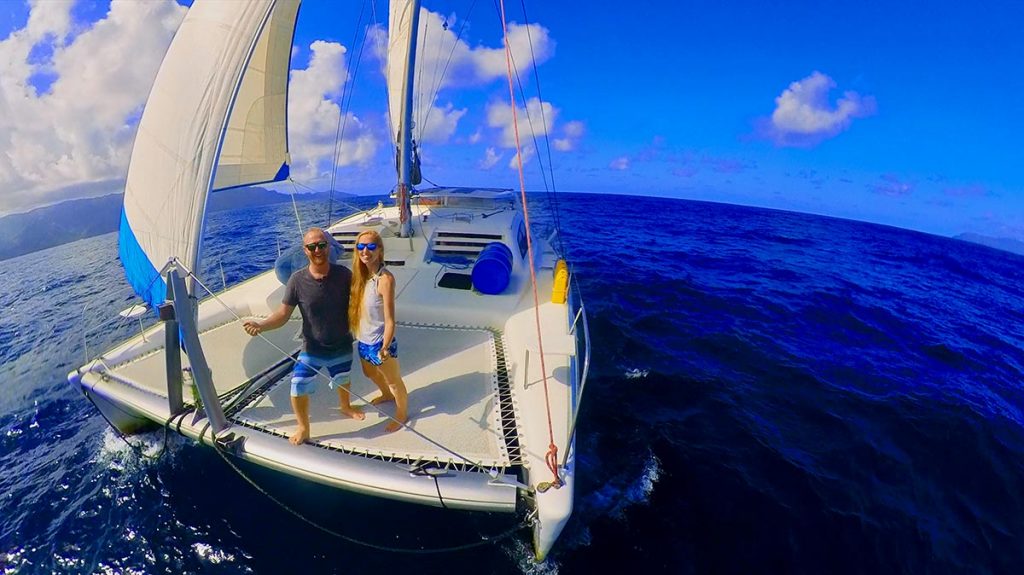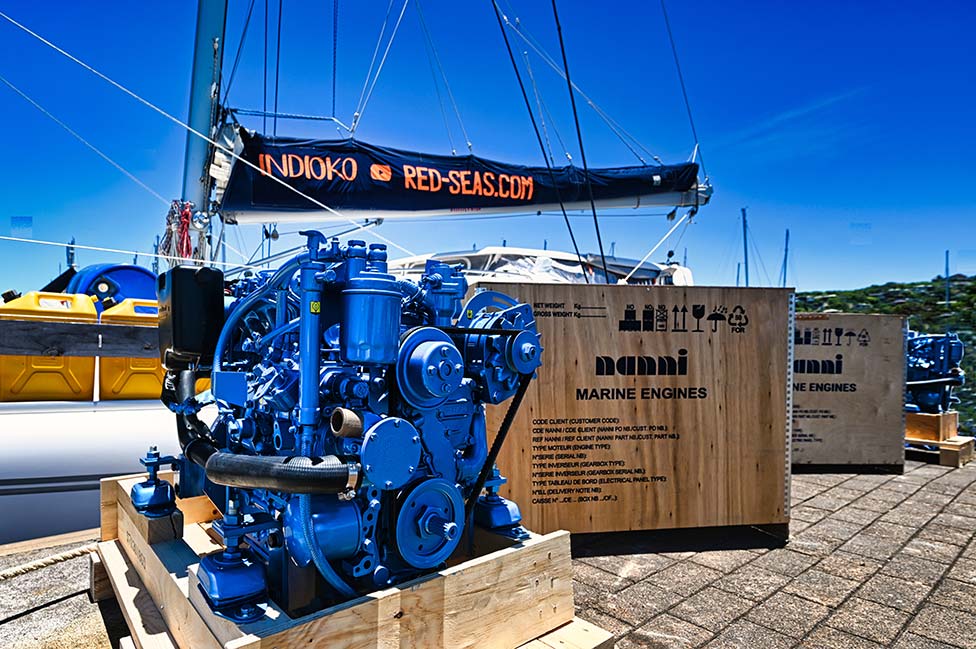Red Seas – S.V. Indioko

We are Iain and Brioni, a Scottish couple who have been living onboard our 20-year-old Leopard 47 sailing catamaran since 2020. We’ve sailed over 10,000nm in the Caribbean, Central America and the South Pacific and we’ve shared the whole journey on our YouTube channel, Sailing Red Seas.
Before we bought her, SV Indioko was heavily chartered for the first 15 years of her life, and we have been consistently renovating and refitting her to turn an empty shell into a true bluewater cruising vessel. We’ve added just about every system: 2200W solar panels, 600Ah lithium batteries, a watermaker, a freezer, a bow sprit and state of the art navigation systems with radar and AIS. Starting out with a very tight budget means that we’ve had to learn how to do all this work ourselves, including fibreglassing our keels back on after a slight running aground incident in the Eastern Caribbean.
Why did you need to upgrade your engines?
Last year, as we made the 4000nm crossing from Panama to the Marquesas islands in French Polynesia, we faced a number of challenges in our 40 days at sea. Being an El Niño year, the weather wasn’t as reliable as expected and after a solid week of battling through non stop lightning storms, we then had to motor for six days to make it through the no-wind zone known as the Doldrums.
After four days of these glassy conditions, our port engine decided enough was enough and chose that moment to spit out all of its coolant and oil and resign from active service. Unable to repair the problem whilst in the middle of the ocean, and noticing a concerning oil leak on the other engine, we vowed to sail every inch of the rest of the journey, no matter how long it took. Several weeks later, as we cautiously arrived into Hiva Oa, French Polynesia and used our dinghy to drag our boat backwards to set the anchor, we were told by an experienced mechanic that our port engine was dead but might be able to be rebuilt if we sailed another thousand miles to Tahiti.
Not wanting to miss out on the adventure along the way, we sailed slowly over the next four months from mountainous islands we had never heard of to uninhabited atolls in the Tuamotus before arriving in Tahiti, only to find the cost and procedure of doing an engine rebuild in one of the most remote countries in the world to be exorbitant and unrealistic.

Why did you choose NANNI?
When we accepted that our position meant we needed to install a new engine in our catamaran, we researched the available options and quickly landed on Nanni as a brand. With Yanmar’s new common rail models being the updated version of the 4JH4Es that we already had, it became apparent that much of the future maintenance and servicing would have to be carried out by a registered technician lest we upset the complex ECU modules with the power to shut down the engine altogether. Unfortunately, these certified technicians can be difficult to find in the remote parts of the world that we typically seek out. Also, with the addition of so many electronics, simple problems would become difficult to diagnose and repair ourselves, which we know from experience can be critical when you’re in the middle of an ocean.
Our goal was to find rock solid reliability, simple mechanics and easily accessible parts and support for a future life of cruising in remote places. Engines that are based on a kubotu block answer many of these questions and when we found Nanni, their additional features of thermostats built right in the heat exchanger, anodes installed in the exhaust elbow to protect from stray current, and even a handy oil extraction pump connected to the sump pan, won us over.
The NANNI N4.50 also has a max RPM of 2,800, whereas other brands can rev out at 3000RPM to 3600RPM. This provides more torque that will actually work the prop better, giving us more speed at a lower RPM. That means we also get less noise, reduced fuel burn, and less wear and tear.
Given all of the benefits, we we decided to not only replace the broken port engine, but our starboard engine as well.
How did the engines get to you in Tahiti?
Being in the middle of the Pacific Ocean (Tahiti is literally 4000nm from South America and 4000nm from New Zealand) wasn’t ideal when it comes to sourcing boat parts, especially new engines. After speaking with the Nanni distributor un the UK, AR Peachment, they put us in contact with Nanni Australia who have gone above and beyond to help us in our journey to repower our boat. They had several video calls with us to help us decide which engine would be the best match for our current set up, and sorted out all the shipping arrangements to get a pair of N4.50s to us here in Tahiti, including shipping an angled gearbox in from Europe and making bespoke packers so that the new engine mounts would line up perfectly to the existing engine beds on our boat. A month later, and we saw the ship arrive in port and began the process of installation, learning on the job as we went along.
How did you install them?
As mentioned, our budget is pretty tight, and so we knew we’d be installing the engines ourselves. Unfortunately, there aren’t many options of places to haul out in French Polynesia and those that do exist are unbelievably expensive, so we chose to do the work whilst still in the water. Thankfully we found space on a working dock, which we could use to our advantage during the replacement process but there were still plenty of challenges ahead.
We suspect that Roberson & Caine built the Leopard 47 around the original engines and so we started by using a couple of chain hoists to lift the old engines off the engine beds, one rigged up to the end of our boom and another tied to a joist we installed through an inspection hatch into the cabin above. The removal process took us four days as we figured out how to remove every hose and wire, then lift and jostle the old engine backwards in a tight space and then eventually up through the engine bay hatch, all while precariously balancing on some lifting straps.
With the two old engines on the dock, we then reversed the process and used our boom to raise the new engines off the dock, swing them slowly over the lifelines and line them up to the engine hatches below. Thankfully they fitted through the opening perfectly and we gradually lowered them into the engine bay then used that second chain hoist to slowly move them forwards and into place.
We had to do some fibreglass work to raise the old engine beds up by 5cm and then spent about three days assuming there must be a more sophisticated way to align the gearbox to our propellor shaft (spoiler alert: there isn’t). With the engines then bolted in place, we reconnected all the hoses that we had thankfully had the foresight to label clearly, and ran new cable looms up to our helms where we installed new consoles.
29 days after we tied up to the dock, we were ready to turn the key and start problem solving all the mistakes we had made along the way. But somehow, both engines roared into life (except they didn’t roar, it was more of a soft purr) and we were overcome with our new found freedom to take our boat wherever we wanted to go.
A final few adjustments as we adapted our throttle cables and replaced a few seals in our racor fuel filter that had split with age, and then we were back out to life on anchor where we always feel more at home.
We are not mechanics, and we have never done more than an oil change on our engines before, but somehow we just removed and replaced two diesel engines: all by ourselves, whilst in the water, in one of the most remote places on earth. Oh, and it’s cyclone season so we had a week of +40kt winds to deal with in the middle of all that as well.
We cannot wait to set sail again, knowing that we can rely on our new shiny blue engines to see us safely through narrow passes, tight anchorages and calm nights at sea where the wind has just disappeared. Our mission is to seek out and explore the remote places that others never think to visit, and we could not be more excited to be on that path of adventure once again.
